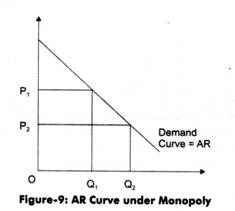Monopoly refers to a market structure in which there is a single producer or seller that has a control on the entire market.
This single seller deals in the products that have no close substitutes and has a direct demand, supply, and prices of a product.
Therefore, in monopoly, there is no distinction between an one organization constitutes the whole industry.
Demand and Revenue under Monopoly:
In monopoly, there is only one producer of a product, who influences the price of the product by making Change m supply. The producer under monopoly is called monopolist. If the monopolist wants to sell more, he/she can reduce the price of a product. On the other hand, if he/she is willing to sell less, he/she can increase the price.
ADVERTISEMENTS:
As we know, there is no difference between organization and industry under monopoly. Accordingly, the demand curve of the organization constitutes the demand curve of the entire industry. The demand curve of the monopolist is Average Revenue (AR), which slopes downward.
Figure-9 shows the AR curve of the monopolist:
In Figure-9, it can be seen that more quantity (OQ2) can only be sold at lower price (OP2). Under monopoly, the slope of AR curve is downward, which implies that if the high prices are set by the monopolist, the demand will fall. In addition, in monopoly, AR curve and Marginal Revenue (MR) curve are different from each other. However, both of them slope downward.
ADVERTISEMENTS:
The negative AR and MR curve depicts the following facts:
i. When MR is greater than AR, the AR rises
ii. When MR is equal to AR, then AR remains constant
iii. When MR is lesser than AR, then AR falls
ADVERTISEMENTS:
Here, AR is the price of a product, As we know, AR falls under monopoly; thus, MR is less than AR.
Figure-10 shows AR and MR curves under monopoly:
In figure-10, MR curve is shown below the AR curve because AR falls.
Table-1 shows the numerical calculation of AR and MR under monopoly:
As shown in Table-1, AR is equal to price. MR is less than AR and falls twice the rate than AR. For instance, when two units of
Output are sold, MR falls by Rs. 2, whereas AR falls by Re. 1.
Monopoly Equilibrium:
ADVERTISEMENTS:
Single organization constitutes the whole industry in monopoly. Thus, there is no need for separate analysis of equilibrium of organization and industry in case of monopoly. The main aim of monopolist is to earn maximum profit as of a producer in perfect competition.
Unlike perfect competition, the equilibrium, under monopoly, is attained at the point where profit is maximum that is where MR=MC. Therefore, the monopolist will go on producing additional units of output as long as MR is greater than MC, to earn maximum profit.
Let us learn monopoly equilibrium through Figure-11:
ADVERTISEMENTS:
In Figure-11, if output is increased beyond OQ, MR will be less than MC. Thus, if additional units are produced, the organization will incur loss. At equilibrium point, total profits earned are equal to shaded area ABEC. E is the equilibrium point at which MR=MC with quantity as OQ.
It should be noted that under monopoly, price forms the following relation with the MC:
Price = AR
MR= AR [(e-1)/e]
ADVERTISEMENTS:
e = Price elasticity of demand
As in equilibrium MR=MC
MC = AR [(e-1)/e]
Exhibit-2:
Determining Price and Output under Monopoly:
Suppose demand function for monopoly is Q = 200-0.4Q
ADVERTISEMENTS:
Price function is P= 1000-10Q
Cost function is TC= 100 + 40Q + Q2
Maximum profit is achieved where MR=MC
To find MR, TR is derived.
TR= (1000-10Q) Q = 1000Q-10Q2
MR = ∆TR/∆Q= 1000 – 20Q
ADVERTISEMENTS:
MC = ∆TC/∆Q = 40 + 2Q
MR = MC
1000 – 20Q = 40 + 2Q
Q = 43.63 (44 approx.) = Profit Maximizing Output
Profit maximizing price = 1000 – 20*44 = 120
Total maximum profit= TR-TC= (1000Q – 10Q2) – (100+ 40Q+Q2)
ADVERTISEMENTS:
At Q = 44
Total maximum profit = Rs. 20844
Monopoly Equilibrium in Case of Zero Marginal Cost:
In certain situations, it may happen that MC is zero, which implies that the cost of production is zero. For example, cost of production of spring water is zero. However, the monopolist will set its price to earn profit.
Figure-12 shows the monopoly equilibrium when MC is zero:
In Figure-12, AR is the average revenue curve and MR is the marginal revenue curve. In such a case, the total cost is zero; therefore, AR and MR are also zero. As shown in Figure-12, equilibrium position is achieved at the point where MR equals zero that is at output OQ and price P.We can see that point M is the mid-point of AR curve, where elasticity of demand is unity. Therefore, when MC = 0, the equilibrium of the monopolist is established at the output (OQ) where elasticity of demand is unity.
ADVERTISEMENTS:
Short-Run and Long-Run View under Monopoly:
Till now, we have discussed monopoly equilibrium without taking into consideration the short-run and long- run period. This is because there is not so much difference under short run and long run analysis in monopoly.
In the short run, the monopolist should make sure that the price should not go below Average Variable Cost (AVC). The equilibrium under monopoly in long-run is same as in short-run. However, in long-run, the monopolist can expand the size of its plants according to demand. The adjustment is done to make MR equal to the long run MC.
In the long-run, under perfect competition, the equilibrium position is attained by entry or exit of the organizations. In monopoly, the entry of new organizations is restricted.
The monopolist may hold some patents or copyright that limits the entry of other players in the market. When a monopolist incurs losses, he/she may exit the business. On the other hand, if profits are earned, then he/she may increase the plant size to gain more profit.





